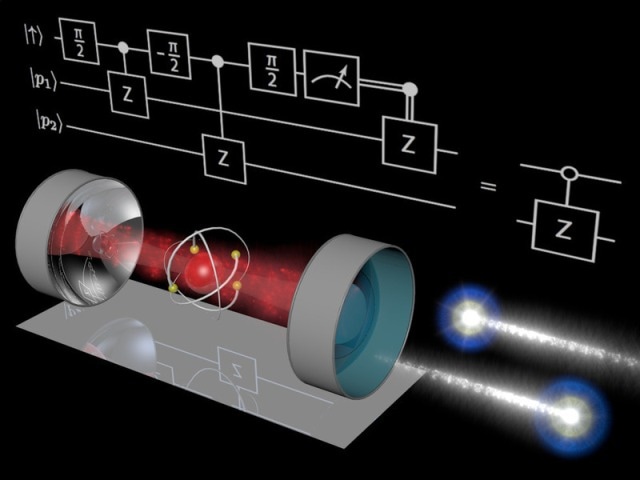Jul 8 2016
A team of scientists from the Quantum Dynamics Division of Professor Gerhard Rempe have successfully realized a quantum logic gate where two light quanta play the key actors. Professor Gerhard Rempe is the director at the Max Planck Institute of Quantum Optics. This attempt was highly challenging as photons do not typically interact at all but pass each other uninterrupted.
 Illustration of the processes that take place during the logic gate operation: The photons (blue) successively impinge from the right onto the partially transparent mirror of a resonator which contains a single rubidium atom (symbolized by a red sphere with yellow electron orbitals). The atom in the resonator plays the role of a mediator which imparts a deterministic interaction between the two photons. The diagram in the background represents the entire gate protocol. (Graphic credit: Stephan Welte, MPQ, Quantum Dynamics Division)
Illustration of the processes that take place during the logic gate operation: The photons (blue) successively impinge from the right onto the partially transparent mirror of a resonator which contains a single rubidium atom (symbolized by a red sphere with yellow electron orbitals). The atom in the resonator plays the role of a mediator which imparts a deterministic interaction between the two photons. The diagram in the background represents the entire gate protocol. (Graphic credit: Stephan Welte, MPQ, Quantum Dynamics Division)
The photons are ideal for the transmission of quantum data, but less appropriate for its processing. The team triumphed over this arduous challenge by introducing a subsidiary third particle into the picture – one atom confined within an optical resonator that acts as a mediator.
The distinct feature of our gate implementation is that the interaction between the photons is deterministic. This is essential for future, more complex applications like scalable quantum computers or global quantum networks.
Dr. Stephan Ritter, Max Planck Institute of Quantum Optics
Data processing in all advanced computers depends on information being binary-coded and then processed with logical operations. This is performed with the use of logic gates which allocate predetermined output values to each input through deterministic protocols. Similarly, for the data processing in quantum computers, quantum logic gates are the essential elements.
To realize a universal quantum computer, it is crucial that every input quantum bit can cause a maximal modification of the other quantum bits. The practical challenge lies in the unique nature of quantum data: in comparison to classical bits, it is not possible to copy them. Applying classical techniques for error correction cannot be done, and the gate has to function for every single photon that conveys data.
Since photons have the special significance as data carriers, for instance, in communicating quantum data in extended quantum networks, the creation of a deterministic photon-photon gate has been a central goal for a long time. One of numerous possibilities to encode photonic quantum bits is the application of polarization states of single photons. Then the states “0” and “1” of a classical bit symbolize two orthogonal polarization states. In the two-photon gate, the each photon’s polarization can manipulate the polarization of the other photon.
As in the classical logic gate, it is specified in advance which input polarization causes which output polarization. For instance, a linear polarization of the second photon is rotated by 90° if the first one is in the logic state “1”, and stays unaffected if the first one is in “0”.
In contrast to classical logic gates, which would be completely specified with this type of description, a quantum gate can employ an infinite number of probable input states. The quantum logic gate has to generate the right combination of output states for each one of these.
In the experiment explained here, two separately polarized photons impinge, in rapid succession, onto a resonator which consists of two high-reflectivity mirrors. Inside a single rubidium atom is trapped, developing a powerfully coupled system with the resonator. The resonator amplifies the impinging photon’s light field at the position of the atom facilitating a direct atom-photon interaction. Consequently, the atomic state is manipulated by the photon as it is being reflected from the mirror. This alteration is sensed by the second photon when it reaches the mirror next.
After their reflection, the two photons are stored in a 1.2-kilometer-long optical fiber for a few microseconds. In the meantime, the atomic state is measured. A rotation of the first photon’s polarization conditioned on the result of the measurement facilitates the back action of the second photon on the first one.
The two photons are never at the same place at the same time and thus they do not see each other directly. Nevertheless, we achieve a maximal interaction between them.
Bastian Hacker, PhD Student, Max Planck Institute of Quantum Optics
The team could establish experimentally that - based on the selection of the photons’ polarizations - either the first photon impacts the second or vice versa. They measured the polarization states of the two outgoing photons for various input states. From these, they produced “truth tables” that match the anticipated gate operations and therefore illustrate the various operational modes of the photon-photon gate.
The case when the input polarization of the two photons is selected so that they manipulate each other is of special interest: in this case, the two outgoing photons develop into an entangled pair.
The possibility to generate entanglement fundamentally distinguishes a quantum gate from its classical counterpart. One of the applications of entangled photons is in the teleportation of quantum states.
Stephan Welte, PhD Student, Mac Planck Institute of Quantum Optics
The team envisions that the new photon-photon gate could lead towards all-optical quantum data processing. “The distribution of photons via an optical quantum network would allow linking any number of network nodes and thus enable the setup of a scalable optical quantum computer in which the photon-photon gate plays the role of a central processing unit (CPU)”, explains Professor Gerhard Rempe. Olivia Meyer-Streng.